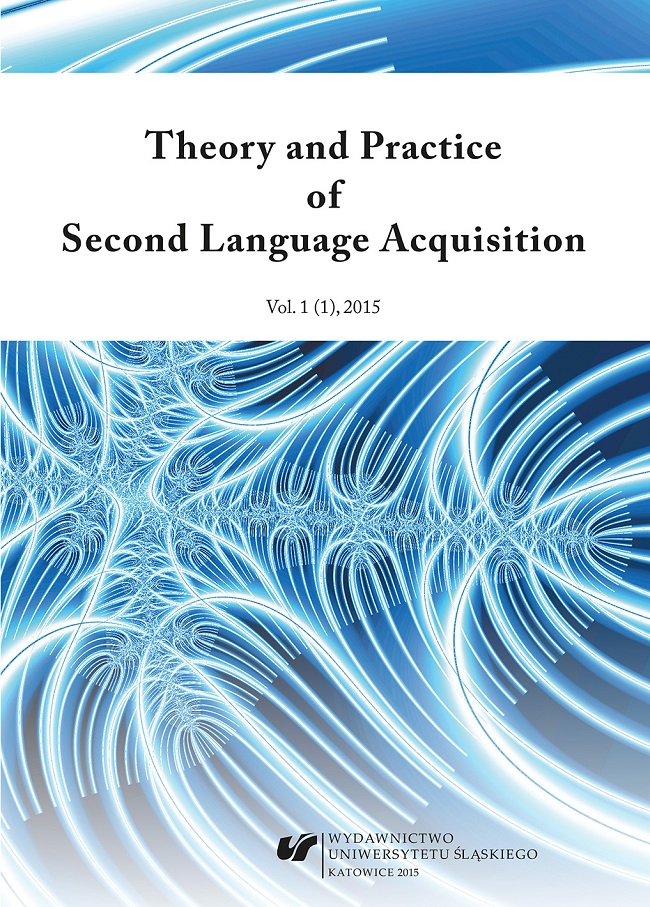Aronin, L. (2012) Material culture of multilingualism and affectivity. Studies in Second Language Learning and Teaching 2 (2), 179-191.
Google Scholar
Atay, D. and Ece, A. (2009) Multiple identities as reflected in English-language education: the Turkish perspective. Journal of Language, Identity and Education 8 (1), 21-34.
Google Scholar
Atkinson, D. (2010) Extended, Embodied Cognition and Second Language Acquisition. Applied Linguistics 31/5, 599-622.
Google Scholar
Barzegar, R., Sadr, S. A. (2013) The effect of emotional intelligence awareness-raisng activities on L2 motivation. Studies in Second Language Learning and Teaching, 3 (1), 67-86.
Google Scholar
Bialystok, E., McBride-Chang, C., Luk, G. (2005) Bilingualism, language proficiency and learning to read in two writing systems. Journal of Educational Psychology 97 (4), 580-590.
Google Scholar
Block, D. (2007). The Rise of Identity in SLA Research, Post Firth and Wagner (1997). The Modern Language Journal 91, 863-876.
Google Scholar
Coffey, S. and Street B. (2008) Narrative and Identity in the “Language Learning Project”. The Modern Language Journal 92 (3), 452-464.
Google Scholar
Cook, V. (1992) Evidence for multicompetence. Language Learning 42 (4), 557-591.
Google Scholar
Edwards, J. (2013) Bilingualism and multilingualism: some central concepts. In T. K. Bhatia and W. C. Ritchie (eds.) The Handbook of Bilingualism and Multilingualism (pp. 5-24), Oxford: Blackwell.
Google Scholar
Edwards, J. ([1994] 2003) Multilingualism. London: Routledge.
Google Scholar
Ehrlich, S. (2001) Gendering the learner: Sexual harassment and second language acquisition. In A. Pavlenko, A. Blackledge, I. Piller and M. Teutsch-Dwyer (eds.) Multilingualism, Second Language Learning and Gender (pp. 103-131), Berlin: Mouton de Gruyter.
Google Scholar
Er, M., Altunay, U. and Yurdabakan, I. (2012) The effects of active learning on foreign language self-concept and reading comprehension achievement. International Journal on New Trends in Education and Their Implications. 3 (4), 43-58.
Google Scholar
Guerra, L. (2012) Learners’ Identity Construction in the Context of English as an International Language. International Journal of Applied Linguistics and English Literature 1 (7), 117-126.
Google Scholar
Hammarberg B. (2010) The languages of the multilingual. Some conceptual and terminological issues. International Review of Applied Linguistics in Language Teaching 48, 91-104.
Google Scholar
Jarvis S. and Pavlenko A. (2008) Crosslinguistic Influence in Language Cognition. London: Routledge.
Google Scholar
Kramsch, C. (2009). The Multilingual Subject. Oxford: Oxford University Press.
Google Scholar
Longman Advanced Dictionary of Contemporary English. New Edition.(2009) Harlow: Pearson Education Limited.
Google Scholar
Marshall S. (2010) Re-becoming ESL multilingual university students and a deficit identity. Language and Education 24 (1), 41-56.
Google Scholar
Muñoz, C. (2006) Age and the Rate of Foreign Language Learning. Clevedon: Multilingual Matters.
Google Scholar
Norton, B. (2000) Identity and Language Learning: Gender, Ethnicity and Educational Change. Harlow: Pearson Education Limited.
Google Scholar
Ohara, Y. (2001) Finding one’s voice in Japanese: A study of the pitch levels of L2 users. In A. Pavlenko, A. Blackledge, I. Piller and M. Teutsch-Dwyer (eds.) Multilingualism, Second Language Learning and Gender (pp. 231-255), Berlin: Mouton de Gruyter.
Google Scholar
Pavlenko, A. ( 2001) How am I to become a woman in an American vein? In A. Pavlenko, A. Blackledge, I. Piller and M. Teutsch-Dwyer (eds.) Multilingualism, Second Language Learning and Gender. (pp. 133-174), Berlin: Mouton de Gruyter.
Google Scholar
Pavlenko, A., Blackledge, A., Piller, I. and Teutsch-Dwyer, M. (eds.) (2001) Multilingualism, Second Language Learning and Gender. Berlin: Mouton de Gruyter.
Google Scholar
Pavlenko, A. (2012) “Affective processing in bilingual speakers: Disembodied cognition?” International Journal of Psychology 47 (6), 405-428.
Google Scholar
Pavlenko, A. ( 2007) Emotions and Multilingualism. Cambridge: Cambridge University Press.
Google Scholar
Peirce, N., B. (2000) Identity and Language Learning: Gender, Ethnicity and Educational Change. Harlow: Pearson Education Limited.
Google Scholar
Research Area Report C. Second phase: Key findings “Multilingualism and education” (2008-2009) Linee – Online document: http://linee.info/index.php?eID=tx_nawsecuredl&u=0&file=fileadmin/user_upload/pdf/D27_AreaC_151209.pdf&t=1409140290&hash=8c7007d88d6f1b1051e2c789c8b34f7d&PHPSESSID=9c9cacec994eb3c6003ca037e59c67d5
Google Scholar
Snow C.E. and Hoefnagel-Höhle, M. (1978) The critical period for language acquisition: Evidence from second language learning. Child Development. 49, pp. 1114-1128.
Google Scholar
Zacharias, N. T. (2012) EFL students’ understanding of their multilingual English identities. Electronic Journal of Foreign Language Teaching 9 (2), pp. 233-244.
Google Scholar



 10.31261/tapsla
10.31261/tapsla